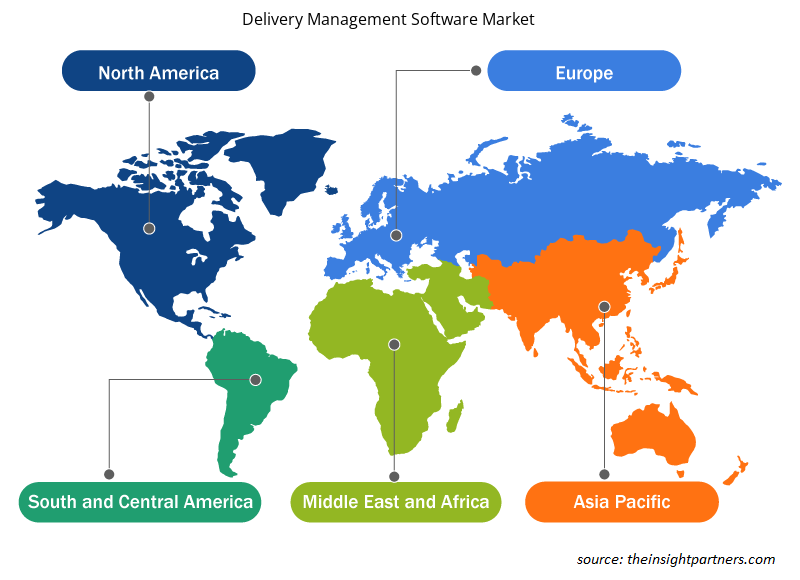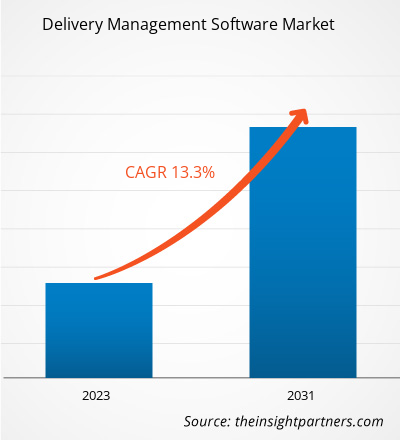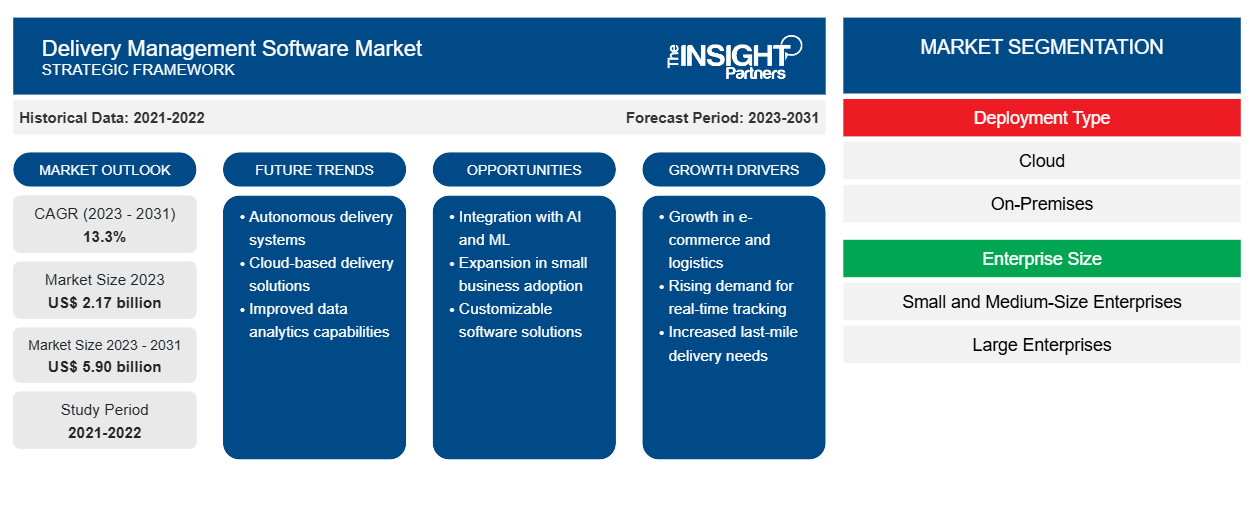배송 관리 소프트웨어 시장 규모는 2023년 21억 7천만 달러에서 2031년 59억 달러로 성장할 것으로 예상됩니다. 이 시장은 2023년부터 2031년까지 13.3%의 CAGR을 기록할 것으로 예상됩니다.
고객 경험 향상을 위해 배송 관리 소프트웨어에 AI와 ML 기술을 통합하는 것은 앞으로도 배송 관리 소프트웨어 시장의 주요 동향이 될 가능성이 높습니다.
배송 관리 소프트웨어 시장 분석
배송 관리 소프트웨어 시장은 전자상거래 산업의 확대와 물류 및 공급망 관리를 위한 실시간 정보에 대한 수요 증가로 인해 빠른 속도로 성장하고 있습니다. 시장은 인구 증가, 디지털화 증가, 온라인 쇼핑에 대한 소비자 선호도에 따라 꾸준히 확장되고 있습니다. 게다가 최종 사용자의 자동화에 대한 수요 증가는 시장 성장에 수익성 있는 기회를 제공하고 있습니다.
배송 관리 소프트웨어 시장 개요
배송 관리 소프트웨어는 배송을 추적하고 고객에게 품목을 적시에 배송하는 데 사용됩니다. 혁신적인 배송 관리 소프트웨어를 사용하면 자산 활용도 증가, 고객 만족도 향상, 연료 사용량 감소 등 기업에 상당한 이점이 있습니다. 이 소프트웨어는 단일 플랫폼에서 배송 기사와 백엔드 사무실을 연결하고 기사가 품목을 배송하는 데 필요한 정보를 제공합니다. 실시간 정보에 대한 수요 증가와 향상된 배송 추적으로 시장이 활성화되고 있습니다.
귀하의 요구 사항에 맞게 이 보고서를 사용자 정의하세요
이 보고서의 일부 또는 국가 수준 분석, Excel 데이터 팩을 포함하여 모든 보고서에 대한 사용자 정의를 무료로 받을 수 있으며 신생 기업 및 대학을 위한 훌륭한 혜택과 할인 혜택을 이용할 수 있습니다.
-
이 보고서의 주요 시장 동향을 알아보세요.이 무료 샘플에는 시장 동향부터 추정 및 예측까지 다양한 데이터 분석이 포함됩니다.
배송 관리 소프트웨어 시장 동인 및 기회
확대되는 전자상거래 산업이 시장을 주도하고 있습니다
확장되는 전자상거래 산업과 소비자들 사이에서 증가하는 최종 마일 배송 서비스에 대한 수요가 시장을 촉진하고 있습니다. 전자상거래 사업은 점점 더 많은 소비자들이 편리한 옵션으로 온라인 쇼핑을 선호함에 따라 전 세계적으로 빠르게 확장되고 있습니다. 이로 인해 소비자들 사이에서 배송 서비스, 특히 최종 마일 배송에 대한 수요가 급증하고 있습니다. 최종 마일 배송은 전자상거래 사업의 중요한 부분입니다. 여기에는 창고에서 고객의 현관까지 상품을 운송하는 것이 포함됩니다. 전자상거래 사업은 상품이 고객에게 빠르고 비용 효율적으로 도달하도록 하는 데 중점을 두고 있으며, 이로 인해 기업 사이에서 배송 관리 소프트웨어에 대한 수요가 증가하고 있습니다. 그러나 전자상거래 산업의 확장과 소비자들의 선호도가 온라인 쇼핑으로 전환되면서 시장이 촉진되고 있습니다.
최종 사용자의 자동화에 대한 수요 증가 – 배송 관리 소프트웨어 시장의 기회
최첨단 기술의 등장은 배달 관리 소프트웨어 시장에 수익성 있는 성장 잠재력을 제공합니다. 배달 관리 소프트웨어 시장의 대형 기업은 배달 프로세스를 자동화하기 위해 AI 및 ML 기술 도입에 상당한 투자를 하고 있습니다. 게다가 자동화는 기업이 주문 이행 및 배달 절차를 개선하도록 지원함으로써 배달 관리에서 큰 인기를 얻고 있습니다. 자동화는 레스토랑 배달, 물류, 택배 사업 등과 같은 최종 사용자가 절차를 간소화하고 비용을 절감하며 고객 경험을 개선하는 데 도움이 됩니다. 경로 최적화, 셀프 서비스 포털, 자동 배달과 같은 수많은 자동화 기술은 물류 회사에서 더 빠르고 효과적인 제품 배송을 위해 널리 채택되고 있습니다.
배송 관리 소프트웨어 시장 보고서 세분화 분석
배달 관리 소프트웨어 시장 분석에서 중요한 요소는 배포 유형, 기업 규모, 최종 사용자입니다.
- 배포 유형에 따라, 배달 관리 소프트웨어 시장은 클라우드와 온프레미스로 나뉩니다. 클라우드 세그먼트는 2023년에 더 큰 시장 점유율을 차지했습니다.
- 기업 규모 측면에서, 배송 관리 소프트웨어 시장은 중소 규모 기업과 대기업으로 나뉩니다. 대기업 부문은 2023년에 더 큰 시장 점유율을 차지했습니다.
- 최종 사용자를 기준으로 시장은 레스토랑 배달, 물류, 택배 사업 등으로 세분화됩니다. 물류 부문은 2023년에 시장에서 가장 큰 점유율을 차지했습니다.
지역별 배송 관리 소프트웨어 시장 점유율 분석
배송 관리 소프트웨어 시장 보고서의 지리적 범위는 주로 북미, 아시아 태평양, 유럽, 중동 및 아프리카, 남미/남중미의 5개 지역으로 나뉩니다.
매출 측면에서 아시아 태평양 지역은 가장 큰 배송 관리 소프트웨어 시장 점유율을 차지했으며, 전자상거래 부문이 확대되고, 인구가 증가하고, 소비자들이 온라인 쇼핑을 선호합니다. 기업들이 추가 물류 비용을 줄여 배송 프로세스를 간소화하기 위해 배송 관리 소프트웨어에 대한 수요가 증가하면서 시장이 성장하고 있습니다. 게다가 기술 발전과 제품 배송을 적절히 관리하기 위한 클라우드 기반 소프트웨어에 대한 수요 증가로 시장에서 기회가 창출되고 있습니다.
배송 관리 소프트웨어 시장 뉴스 및 최근 개발
배달 관리 소프트웨어 시장은 1차 및 2차 조사 이후의 질적, 양적 데이터를 수집하여 평가합니다. 여기에는 중요한 기업 간행물, 협회 데이터 및 데이터베이스가 포함됩니다. 다음은 배달 관리 소프트웨어 및 전략 시장의 개발 목록입니다.
- 2024년 2월, Inspire Brands는 배달 채널을 간소화하기 위해 'Vromo'를 인수했습니다. Vromo는 최종 고객에게 배달 추적 혜택을 제공하여 Inspire Brands가 배달 프로세스를 운영할 수 있도록 지원하는 온라인 식품 배달 소프트웨어입니다. (출처: Inspire Brands, 보도자료, 2024)
배송 관리 소프트웨어 시장 지역 통찰력
Insight Partners의 분석가들은 예측 기간 동안 배달 관리 소프트웨어 시장에 영향을 미치는 지역적 추세와 요인을 철저히 설명했습니다. 이 섹션에서는 북미, 유럽, 아시아 태평양, 중동 및 아프리카, 남미 및 중미의 배달 관리 소프트웨어 시장 세그먼트와 지리에 대해서도 설명합니다.

- 배송 관리 소프트웨어 시장을 위한 지역별 데이터 얻기
배송 관리 소프트웨어 시장 보고서 범위
| 보고서 속성 | 세부 |
|---|---|
| 2023년 시장 규모 | 21억 7천만 달러 |
| 2031년까지 시장 규모 | 59억 달러 |
| 글로벌 CAGR (2023-2031) | 13.3% |
| 역사적 데이터 | 2021-2022 |
| 예측 기간 | 2023-2031 |
| 다루는 세그먼트 |
배포 유형별
|
| 포함된 지역 및 국가 |
북아메리카
|
| 시장 선도 기업 및 주요 회사 프로필 |
|
배송 관리 소프트웨어 시장 참여자 밀도: 비즈니스 역학에 미치는 영향 이해
배달 관리 소프트웨어 시장은 소비자 선호도의 변화, 기술 발전, 제품의 이점에 대한 인식 증가와 같은 요인으로 인해 최종 사용자 수요가 증가함에 따라 빠르게 성장하고 있습니다. 수요가 증가함에 따라 기업은 제품을 확장하고, 소비자의 요구를 충족하기 위해 혁신하고, 새로운 트렌드를 활용하여 시장 성장을 더욱 촉진하고 있습니다.
시장 참여자 밀도는 특정 시장이나 산업 내에서 운영되는 회사나 기업의 분포를 말합니다. 주어진 시장 공간에 얼마나 많은 경쟁자(시장 참여자)가 존재하는지 그 규모나 전체 시장 가치에 비해 나타냅니다.
배송 관리 소프트웨어 시장에서 운영되는 주요 회사는 다음과 같습니다.
- 델리포스 테크놀로지스 프라이빗 리미티드
- FarEye (로보틱웨어스 주식회사)
- 겟스위프트 리미티드
- 정글웍스
- 로그인ext Solutions Private Limited
- 모비소프트 인포텍 LLC
면책 조항 : 위에 나열된 회사는 어떤 특별한 순서에 따라 순위가 매겨지지 않았습니다.

- 배송 관리 소프트웨어 시장 주요 업체 개요를 알아보세요
배송 관리 소프트웨어 시장 보고서 범위 및 제공물
"배달 관리 소프트웨어 시장 규모 및 예측(2023-2031)" 보고서는 아래 영역을 포괄하는 시장에 대한 자세한 분석을 제공합니다.
- 범위에 포함된 모든 주요 시장 세그먼트에 대한 글로벌, 지역 및 국가 수준의 시장 규모 및 예측
- 동인, 제약 및 주요 기회와 같은 시장 역학
- 주요 미래 트렌드
- 자세한 PEST/포터의 5가지 힘과 SWOT 분석
- 주요 시장 동향, 주요 업체, 규정 및 최근 시장 동향을 포괄하는 글로벌 및 지역 시장 분석
- 시장 집중도, 히트맵 분석, 유명 기업 및 최근 개발 사항을 포함하는 산업 환경 및 경쟁 분석
- 자세한 회사 프로필
- 과거 분석(2년), 기준 연도, CAGR을 포함한 예측(7년)
- PEST 및 SWOT 분석
- 시장 규모 가치/거래량 - 글로벌, 지역, 국가
- 산업 및 경쟁 환경
- Excel 데이터세트
최근 보고서
관련 보고서
사용 후기
구매 이유
- 정보에 기반한 의사 결정
- 시장 역학 이해
- 경쟁 분석
- 고객 인사이트
- 시장 예측
- 위험 완화
- 전략 기획
- 투자 타당성 분석
- 신흥 시장 파악
- 마케팅 전략 강화
- 운영 효율성 향상
- 규제 동향에 발맞춰 대응























 무료 샘플 받기 - 배송 관리 소프트웨어 시장
무료 샘플 받기 - 배송 관리 소프트웨어 시장